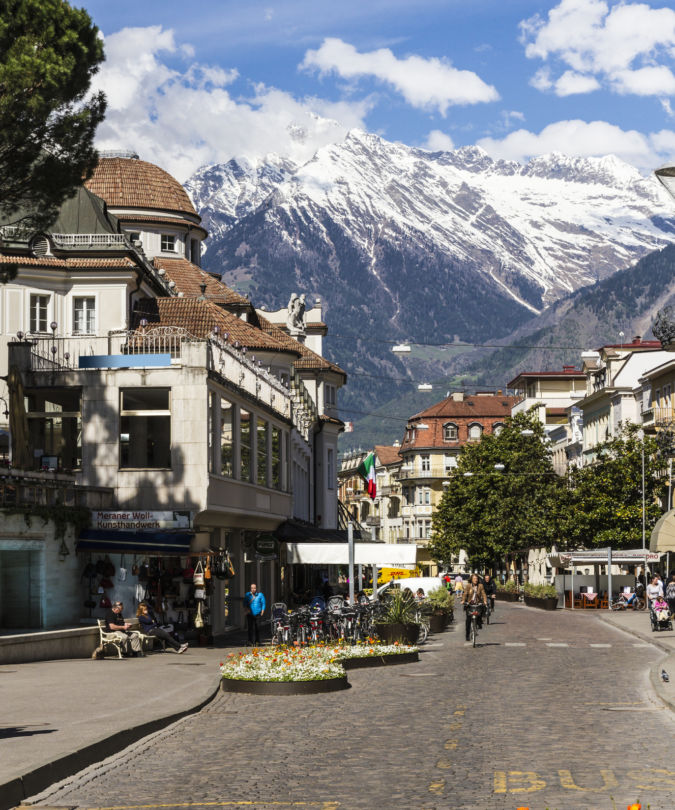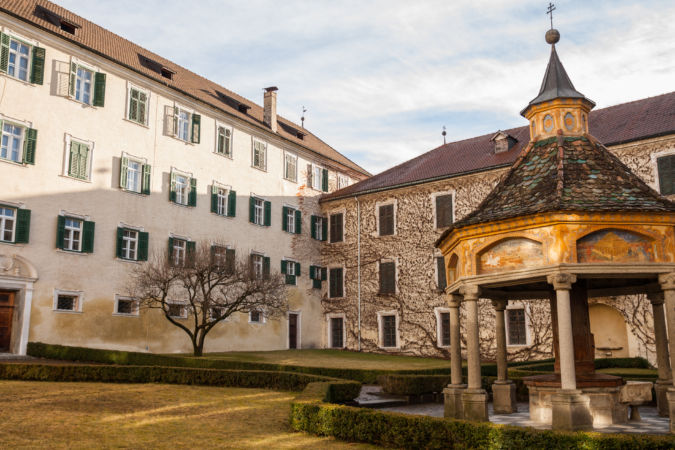First-time visitors to Alto Adige might spend their first days confused as to where they actually are. This mountainous region, best known for its excellent wines and fantastic winter skiing offered by the Dolomites, is clearly in Italy, but you might find yourself checking the map just to confirm it. Why are the road signs and signposts in German? Why are most names German, and why do most people – indeed, around 65% – speak German as their first language? And for that matter, why is there so little pasta and Chianti on restaurant menus?
This is Italy, but not as you know it. Indeed, it is not really like anywhere else in this famously beautiful and wonderfully varied land.
Trentino/Alto Adige, or Südtirol to give the region its German moniker, became part of the then Kingdom of Italy almost exactly 100 years ago after the collapse and break-up of the Hapsburg Empire. Only under Mussolini did Italians settle here in any significant numbers; census figures suggest they are still a minority, with most of the hotels, wineries and other businesses controlled by native German speakers. Native Italian speakers do grumble at these disparities, but not so much; this is the wealthiest part of Italy, its inhabitants the longest-lived – thanks probably to the good diet and clean air – and for me, one of the most interesting and beautiful, with lots to see. There is wonderful food – the cuisine can best be described as Germanic with a distinct Italian twist and a focus on freshness – and of course, memorable high-altitude wine. Richly aromatic whites such as Gewurztraminer, Pinot Blanc and Pinot Grigio sit alongside curiosities like Kerner and Müller Thurgau, and perfumed, ethereal reds, with the best Pinot Noir in Italy and spicy, moreish local varieties Lagrein and Schiava (aka Trollinger and Vernatsch). All combine to make most stays unforgettable.
This is Italy, but not as you know it
Most visitors start in Bolzano/Bolzen, a handsome town at the foot of the Dolomites, whose lack of obvious attractions is countered by a relaxed lifestyle. There are some great shops and restaurants in Via Portici/Laubengasse, its famous, long arcaded main thoroughfare (for informal dining, try either the Fink Gasthaus or Italia & Amore, great for pizzas and fish respectively) and lively main squares, the Piazza delle Erbe/Obstplatz and Piazza Walther/Waltherplatz, home to Bolzano’s cathedral. Bolzano is rightly famous for its atmospheric Christmas market, but it hosts a wonderful foodie market on most weekdays (the cheese stalls are particularly recommended).


It’s been ten years since Bolzano’s Renon cable car opened, and the dramatic 15 minute trip up to Oberbozen is still one of the best things to do here; at the top are bars, restaurants and spectacular Tyrolean views. A small train takes you to local villages where you can take a range of scenic walks and have lunch at various gasthäuser.
Renting a car is a must, and your first stop should be the impossibly attractive town of Merano, with wonderful art nouveau buildings, a historic spa hotel and great restaurants set alongside the river Passer. The delightful Passeggiata d’Inverno, a walk from the centre of town near the famous stone bridge Steinerner Steg, alongside lovely gardens with wonderful views is another must-do; there are lots of cafes and places to dip your feet into the beautifully clear – though freezing – water.


If you drive only a part of Alto Adige’s beautiful wine route, make it the road south of Bolzano alongside Lake Caldaro. This will take you to the beautiful village of Margeid/Magre, where you can taste the wonderful biodynamic wines of Alois Lageder and eat great local produce, much of it from Lageder’s property. En route, you’ll pass some of the region’s most famous wine producers including Elena Walch and J. Hoffstatter, famous for their Pinot Biancos, Pinot Grigios and Gewurztraminer.
You also pass by two of Alto Adige’s best wine cooperatives: Cantina Caldaro/Kaltern, famous for its take on the region’s historic red variety Sciava, and Cantina Tramin/Termeno, with its new green metal and glass winery in the village of Tramin, claimed by some to be the original home of Gewurztraminer. Willi Sturz is an award-winning winemaker, and in the Cantina’s tasting room with its impressive views over the vineyards and mountains you can taste the Nussbaumer Gewurztraminer and Stoan, a moreish, rounded blend of Chardonnay, Sauvignon Blanc, Gewurztraminer and Pinot Bianco.

Over a tasting in his delightful Vineria Paradeis restaurant in Magre, Lageder says that the region’s great strength is making wine in styles that are today very much in vogue.
“We’ve won a reputation for our whites, but are increasingly being recognised for our reds, not just our Pinot Noir which is rightly world-famous, but also other varieties like Lagrein. And climate change means that varieties you would never have associated with South Tyrol – like Cabernet Franc, Merlot and even Tannat – now grow very well here.”
Lageder says one of the region’s most modern wines is Magdalener, a traditional Bolzano blend of 85% Sciava and 15% Lagrein. His Romigberg 2017 is a great example, oak-fermented and rounded but also easy drinking thanks to its low tannins and controlled acidity.
You could spend weeks visiting the picturesque castles dotted around this region, but if time is short you might be better off visiting Abbazia di Novacella in Valle Isarco, north-east of Bolzano. This huge and picturesque Augustinian Monastery was founded in 1142 and is still home to some monks; its famous library – one of the oldest in Italy – beautiful Baroque chapel and impressive grounds are well worth a visit. Many are also attracted to the wine produced here, typically 800,000 bottles of which some 70% is white, with the Sylvaner, the Gewurtztraminer and the Kerner – a 1929 crossing between Riesling and Schiava – particularly prized.

“More and more Alto Adige is recognised as a high quality region, with strengths in the diversity in soils, micro-climates and grape varieties,” says Werner Waldboth, sales director at Abbazia di Novacella. Lageder echoes this: “What makes Alto Adige wines unique are their freshness and purity.”
You could say the same for the region generally. Despite the appeal of its historic towns, villages and castles, this is a special place where nature is never far away.
Lagerder wines are imported by Bibendum; Cantina Tramin by Hallgarten; J.Hofstatter by Berkmann; Abbazia di Novacella by Astrum; Cantina Kaltern by Ellis of Richmond and Elena Walch by Bancroft Wines.
Explore more of Italy with our feature on Massimo Ferragamo’s Tuscan paradise – Castiglion del Bosco – or read about the wines of Romania and Cyprus.






